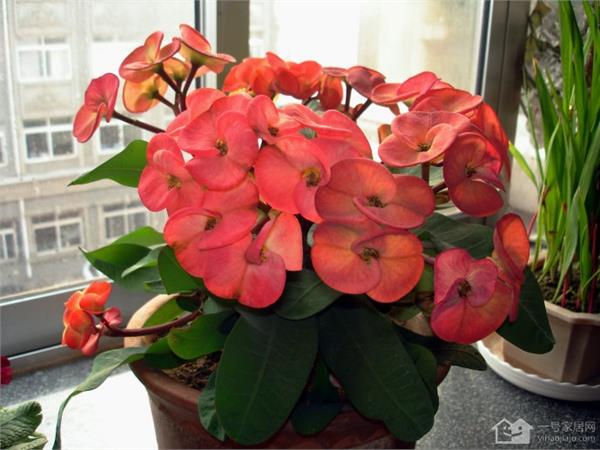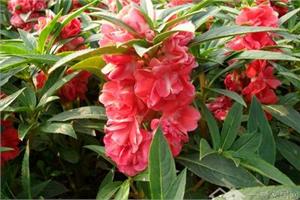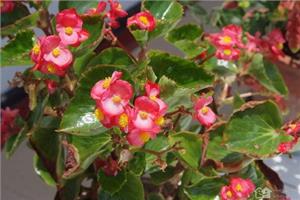Introduction to the culture conditions and methods of lipstick orchid
Tiger thorn plum is one of our common household plants, with thorns on the branches and red flowers at the top, exquisite and chic, very good-looking, tiger thorn plum breeding at home balcony, window sill and other places can not only decorate the home, but also have certain benefits in anti-theft, let's take a look at the tiger thorn plum culture methods.

First, the basic information of tiger thorn plum
Tiger thorn plum is called "unicorn thorn" and "tiger thorn". It is a popular indoor plant and is grown in gardens in the tropics. Deciduous shrub with dense brown stiff spines on stems and broad lanceolate leaves. Deciduous leaves during winter dormancy. Tiger thorn plum likes a warm, moist and sunny environment. Slightly resistant to shade, high temperature, drought-resistant, not cold-resistant. The rotten leaf soil with loose and good drainage is the best. Prunus przewalskii is a prickly erect or slightly climbing shrub with a height of 1m, much branched and white sap in its body. The flower shape is very small, born at the top of the branch, the flower color is bright red, the florescence is long, but the spring flower is the most prosperous. Because the flower shape is like plum, and the stem is prickly, it is known as tiger prickly plum. Prunus przewalskii stem slightly scandent, branched, up to 2 meters long. There are thick gray thorns on the stem and the leaves are ovate. The flowers are small and form small clusters in pairs. There are two reddish bracts on the outside. Bracts are yellow and crimson. The stems and branchlets of Prunus przewalskii are angled, the furrow is shallow, densely covered with conical spikes, the thorns are 1 Mel 1.5 mm in length and 0.5 mi mi 1.0 mm in diameter. Leaves alternate, often densely attached to the tip of new branches, Obovate or oblong-spatulate. Prunes sessile or subsessile; stipules subulate, caducous. Involucral bracts campanulate; several male flowers; 1 female flower. Flowering in winter and spring. Capsule trigonous-ovate. Bracts 2, kidney orbicular, bright red above, reddish below, close to inflorescence.
Second, the culture method of tiger thorn plum
The main results are as follows: 1. The reproduction method of Prunus przewalskii: it can be divided into two propagation methods: cuttage propagation and tissue culture.
The main results are as follows: 1) the tiger thorn plum is mainly propagated by the tiger thorn plum. It can be inserted throughout the growing period, but it is best to do it in 5murine-June, with a high survival rate. Select the mature branches of last year and cut them into 6murmur10cm segments, with the top branch as good as possible. White milk flows out of the cut, wash it with warm water to dry, and then insert it into the sand bed. Keep it slightly dry and take root about 30 days after insertion.
2) tissue culture of Chimonanthus przewalskii: the cuttage propagation method is generally adopted, but the reproduction coefficient per thorn is low and the speed is slow, so it is difficult to achieve large-scale, commercial and standardized production, so large-scale propagation is generally carried out by tissue culture. can achieve better results. Chimonanthus przewalskii is a very popular indoor ornamental plant with long flowering period, bright color, elegant shape and easy cultivation, so many people choose potted plants for decoration and beautification, and many people choose to plant in the courtyard, which also has a good effect.
2. Potted plants should not be watered too much when changing pots every spring. Summer and autumn growth needs sufficient water for a long time, fertilizing once a month. When the temperature is low in winter, the leaves fall off and enter the dormant period, the basin soil should be kept dry. 3Mel-December florescence, the flowers can bloom continuously when the soil moisture is kept moderate, and can continue to blossom if the room temperature is above 15 ℃ in winter. When the growth of the plant is too crowded and dense, the whole plant can be pruned before new leaves germinate in spring.
3. Prunus angustifolia is special in nature and grows slowly, only about 10 centimeters a year, but it has a long life, and potted plants can live for more than 30 years. The flowering period is long, if the light and temperature are suitable, it can open all the year round. The branches of Prunus mume are not easy to branch, grow very long, blossom less, and their posture is messy, affecting ornamental, so they must be pruned and pointed in time every year to make them send out more new branches and blossom more. Generally, two new branches can be produced after picking off the tip. Prunus przewalskii has developed root system and exuberant growth, which can be used as the rootstock of grafting fairy finger and crab claw orchid, but it belongs to shallow root system, which walks far away, but there is not much root hair.
4. Prunus mandshurica likes warmth and is not resistant to cold. It grows best at about 22 ℃ in daytime and 15 ℃ at night. It keeps 15 ℃ to 20 ℃ in greenhouse and blossoms all the year round. If it falls to 10 ℃, the fallen leaves turn into semi-dormant state, reveal new leaves in the next spring and continue to blossom. Tiger thorn plum Xiguang, the more abundant sunshine before the flower, the more bright flowers, long-lasting, lack of light, then the color is dim, long-term shade, then do not blossom. Attention should also be paid to maintaining good ventilation.
5. Prunus angustifolia can be used as base fertilizer, fertilizing every half a month during the growing period, stop fertilizing after the beginning of autumn, avoid using fertilizer with oil to prevent root rot. Tiger thorn plum is resistant to drought, and watering in spring and autumn should be dry and wet. Can be watered once a day in summer, waterproof in rainy season, not dry and watered in winter, the basin should not be moist for a long time; the flowering period should also be controlled, the water is easy to cause falling flowers and rotting roots.
The above is the relevant introduction of this article, I believe you have a simple understanding of this after reading it, if necessary, you can continue to pay attention to the No. 1 home network for more information.
Related
- Wuhan Hospital Iron Tree Blooming Result Was Instantly Frightened by the Gardener Master
- Which variety of camellia is the most fragrant and best? Which one do you like best?
- What is the small blue coat, the breeding methods and matters needing attention of the succulent plant
- Dormancy time and maintenance management of succulent plants during dormancy
- Minas succulent how to raise, Minas succulent plant pictures
- What are the varieties of winter succulent plants
- How to raise succulent plants in twelve rolls? let's take a look at some experience of breeding twelve rolls.
- Attention should be paid to water control for succulent plants during dormant period (winter and summer)
- Watering experience of twelve rolls of succulent plants
- Techniques for fertilizing succulent plants. An article will let you know how to fertilize succulent plants.



